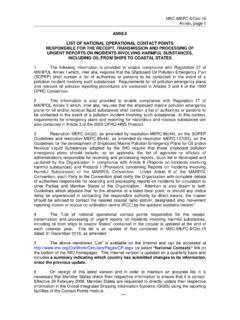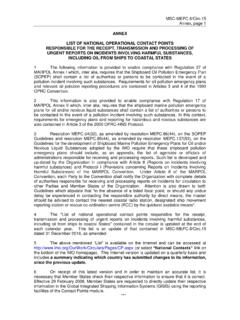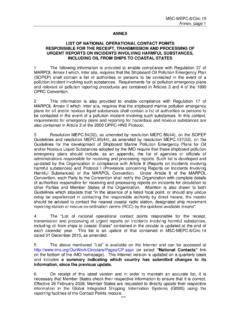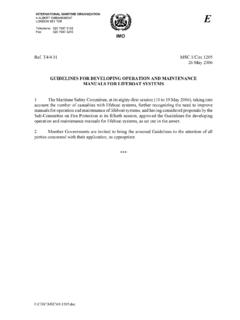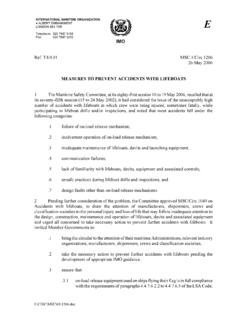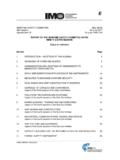Transcription of AIR POLLUTION AND ENERGY EFFICIENCY …
1 Documents/English/ mepc (E).docx E MARINE environment protection COMMITTEE 70th session Agenda item 5 mepc 70 25 July 2016 ENGLISH ONLY AIR POLLUTION AND ENERGY EFFICIENCY Assessment of fuel oil availability final report Note by the Secretariat SUMMARY Executive summary: This document provides in the annex the complete final report of the "Assessment of fuel oil availability" undertaken by CE Delft. The final report incorporates the executive summary as set out in document mepc 70/5/3 but in addition includes and makes reference to the supporting annexes. Strategic direction: High-level action: Output: Action to be taken: Paragraph 1 Related document: mepc 70/5/3 Action requested of the Committee 1 The Committee is invited to note the complete final report of the Assessment of fuel oil availability, as the basis of the findings of the report's executive summary, set out in document mepc 70/5/3.
2 ** 0 July 2016 - Assessment of Fuel Oil Availability 1 1 Table 33 Assessment of Fuel Oil Availability Final report 1 July 2016 - Assessment of Fuel Oil Availability This report is prepared by: CE Delft Stratas Advisors UMAS NMRI Petromarket Research Group Shinichi Hanayama Delft, CE Delft, July 2016 Publication code: Client: International Maritime Organization (IMO) CE publications are available from Further information on this study can be obtained from the contact person, Jasper Faber (CE Delft). copyright, CE Delft, Delft Assessment of Fuel Oil Availability Final report CE Delft Committed to the environment Through its independent research and consultancy work CE Delft is helping build a sustainable world.
3 In the fields of ENERGY , transport and resources our expertise is leading-edge. With our wealth of know-how on technologies, policies and economic issues we support government agencies, NGOs and industries in pursuit of structural change. For 35 years now, the skills and enthusiasm of CE Delft s staff have been devoted to achieving this mission. 2 July 2016 - Assessment of Fuel Oil Availability Authors CE Delft Jasper Faber (lead author) Saliha Ahdour Maarten t Hoen Dagmar Nelissen Stratas Advisors Anjani Singh (lead author) Petr Steiner Sergio Rivera UMAS Carlo Raucci Tristan Smith NMRI Eiichi Muraoka Petromarket Research Group Yakov Ruderman Ivan Khomutov Independent Shinichi Hanayama 3 July 2016 - Assessment of Fuel Oil Availability Figures Figure 1 Schematic overview of ENERGY demand model 24 Figure 2 ENERGY use per ship type in 2012 and 2020 26 Figure 3 Decomposition of changes in ENERGY use between 2012 and 2020, base case 27 Figure 4 Cost-effectiveness of EGCSs as a function of engine size 30 Figure 5 Refinery capacity increases 2012 - June 2019 65 Figure 6 Global maritime fuel demands in 2012.
4 Top-down approach (IEA datasets) and bottom-up approach (Third IMO GHG Study 2014) 77 Figure 7 2007-2012 adjusted marine fuel sales based on quantitative uncertainty results 78 Figure 8 Updated uncertainty on IEA data (top-down) and bottom-up fuel inventories for all ships including 2012 IEA statistics 79 Figure 9 Top-down (IEA data) and bottom-up (Third IMO GHG Study 2014) estimates in 2012 with relative lower and upper bounds by fuel type 80 Figure 10 Percentages of marine fuel consumptions in 2012 apportionable to an incremental number of regions 82 Figure 11 Refinery flow sheet for residual fuel oil desulphurization 85 Figure 12 Gasoline Sulphur Content - 2020 102 Figure 13 On-road diesel sulphur content 103 Figure 14 Graphical representation of EGCS uptake model 138 Figure 15 EGCSs are more cost-effective for ships with larger engines 143 Figure 16 Change in demand for fuels with a sulphur content of m/m or less 152 Figure 17 Overview type of respondents online survey 153 Figure 18 Schematic presentation of the emissions projection
5 Model 155 Figure 19 Historical data on world coal and oil consumption, coal and oil transported (upper panel), total (non-coal) bulk dry goods, other dry cargoes and global GDP (lower panel) 159 Figure 20 Growth in world seaborne trade 2012-2015 (billion tonnes miles) from Review of Maritime Transport 2015 163 Figure 21 Development of World GDP 2015-2020 from IMF World Economic Outlook 163 Figure 22 Development of transport work (index 2012=100) plausibility check according to UNCTAD and world GDP projections 164 Figure 23 Schematic overview of the GloTraM model 176 Figure 24 Fuel price projections and sensitivity LNG price projections 177 Figure 25 Comparison between the LNG demand projections in 2020 given by the existing literature and the estimates of this study 180 Figure 26 Comparison of total ENERGY demand by ship types in 2020 between GloTraM and CE Delft s model 181 4 July 2016 - Assessment of Fuel Oil Availability Tables Table 1 Fuel demand projections in the base case, high case and low case in 2020 12 Table 2 Global Refinery Capacity (2012 and mid-2019)
6 12 Table 3 Global Refinery Production (2012 and 2020) - million tonnes per year 13 Table 4 Global shipping fuel consumption in 2012 by fuel type and machinery component based on the Third IMO GHG Study (million metric tonnes) 17 Table 5 Global Refinery Production (2012) - million tonnes per year 18 Table 6 Regional Refinery Utilization rates for major units (2012)(1,2) 19 Table 7 Global Marine Fuel sales as a percentage of refinery production (2012) 19 Table 8 Regional demand for maritime fuels and relative shares in 2012 (million tonnes per year) 20 Table 9 Regional Refinery Production (2012) - million tonnes per year 21 Table 10 Input assumptions for fuel demand projections 23 Table 11 Scenario plausibility checks 25 Table 12 Shipping emissions and transport work, 2007-2012 26 Table 13 EGCS investment costs used in this study 28 Table 14 EGCS operational costs used in this study 29 Table 15 Financial parameters used in this study 29 Table 16 Estimated LNG demand for gas carriers over the period 2012 to 2020 in shipping 33 Table 17 LNG price projection used in this study (USD/tonnes)
7 33 Table 18 LNG capital costs for newbuilds used in this study 34 Table 19 Financial parameters for LNG newbuilds used in this study 34 Table 20 Estimated LNG demand over the period 2012 to 2020 in shipping 35 Table 21 Estimated regional shares for LNG demand over the period 2012 to 2020 in shipping 35 Table 22 Estimated LNG demand in million tonnes over the period 2012 to 2020 in shipping 36 Table 23 LNG potential regional use in 2020 in million tonnes as estimated in this study 37 Table 24 Global and regional marine fuel demand (2020) - base case 38 Table 25 Global marine fuel demand (2020) - low case and high case 39 Table 26 Non-Marine Product Demand (2020) - million tonnes per year(1) 39 Table 27 Total fuel demand in 2020 (million tonnes per year) 40 Table 28 Regions in the supply model 42 Table 29 Refinery products categories used to assess availability of marine fuels in 2020 42 Table 30 Regional Refinery Capacity June 30, 2019 (change since 2012) - million tonnes per year 44 Table 31 Refinery Input, Crude Oil and Quality (2020, (2012)) 45 Table 32 Refinery Products and Crude Oil prices (USD/tonnes except for Brent) 45 Table 33 Global Refinery Production (2020 (2012)) - million tonnes per year 46 Table 34 Base case for Regional Refinery Production (2020, (2012))
8 - million tonnes per year 47 Table 35 Percentage Regional Refinery Capacity Utilization for major units (2020 and 2012) (1,2,3) 48 Table 36 Percentage(1, 2) of sulphur removal on fuel for selected hydrotreating processes - 2020 (2012) 49 Table 37 Global marine fuel demand and supply (2020) base case - million tonnes per year 50 Table 38 Trade flows of HFO < m/m S % for (2020), million tonnes per year 50 Table 39 Supply model runs to assess availability of marine fuels in 2020 - million tonnes per year 51 Table 40 Global marine fuel demand and supply (2020) high case - million tonnes per year 53 Table 41 Global marine fuel trade flow (2020) - million tonnes per year 53 Table 42 Global marine fuel demand and production - low case (2020) million tonnes per year 54 Table 43 Asia and Middle East marine fuel maximum production (2020) - million tonnes per year 55 Table 44 Regional Refinery Maximum Production (2020, (2012)) - million tonnes per year 57 Table 45 Fuel demand projections in the base case, high case and low case 64 5 July 2016 - Assessment of Fuel Oil Availability Table 46 Starting position of regional demand for maritime fuels in 2012 and relative shares 80 Table 47 Regional demand and shares in 2012 from MECL 81 Table 48 Regional S% in petroleum coke from Delayed Coker (2020 (2012))
9 88 Table 49 Regional Refinery Capacity (2012 and (June 30, 2019)) - million tonnes per year 91 Table 50 Refining Capacity and Anticipated Expansions Europe - million barrels per day 92 Table 51 Major Anticipated Expansions Europe - million barrels per day 93 Table 52 Major Anticipated Shutdowns Europe - million barrels per day 93 Table 53 Refining Capacity and Anticipated Expansions Russia & CIS - million barrels per day 93 Table 54 Major Anticipated Expansions Russia & CIS - million barrels per day 94 Table 55 Refining Capacity and Anticipated Expansions Middle East - million barrels per day 94 Table 56 Major Anticipated Expansions Middle East - million barrels per day 94 Table 57 Major Anticipated Shutdowns Middle East - million
10 Barrels per day 95 Table 58 Refining Capacity and Anticipated Expansions Africa - million barrels per day 95 Table 59 Major Anticipated Expansions Africa - million barrels per day 96 Table 60 Refining Capacity and Anticipated Expansions Asia Pacific - million barrels per day 96 Table 61 Major Anticipated Expansions Asia - million barrels per day 96 Table 62 Major Anticipated Shutdowns Asia - million barrels per day 97 Table 63 Refining capacity and Anticipated Expansions North America - million barrels per day 97 Table 64 Major Anticipated Expansions North America - million barrels per day 98 Table 65 Refining Capacity and Anticipated Expansions Latin Amer



